Climate Variability in the Sudanian Zone of Côte d’Ivoire: Weather Observations, Perceptions, and Adaptation Strategies of Farmers
Abstract
:1. Introduction
2. Materials and Methods
2.1. Description of the Study Sites
2.2. Methodology
2.2.1. Analysis of Climatic Variables
- -
- Analysis of interannual variability of precipitation and temperature
For 3 ≤ t ≤ n − 2
- -
- Analysis of the interannual evolution of the duration of the rainy season, the number of rainy days and drought episodes
2.2.2. Analysis of the Perceptions and Adaptation Strategies of Farmers to Climate Variability
3. Results
3.1. Interannual Variability of Precipitation and Temperature over the Period 1987–2018 in the Sudanian Zone
3.2. Farmers’ Perceptions and Adaptation Strategies to Climate Variability
3.2.1. Profile of the Operation
3.2.2. Manifestation and Impacts of Climate Variability in the Sudanian Zone of Côte d’Ivoire
3.2.3. Strategies for Adapting to Climate Variability
4. Discussion
4.1. Rainfall and Thermal Variability in the Sudanian Zone of Côte d’Ivoire
4.2. Farmers’ Characteristics and Perceptions of Climate Variability
4.3. Adaptation Measures of Farmers to Face Climate Variability in the Sudanian Zone of Côte d’Ivoire
5. Conclusions
Author Contributions
Funding
Institutional Review Board Statement
Informed Consent Statement
Data Availability Statement
Acknowledgments
Conflicts of Interest
References
- Kosmowski, F.; Gibigaye, M.; Muller, B.; Lalou, R. Innover en milieu rural ouest-africain Quels changements dans les pratiques agricoles des exploitants? In Les Sociétés Rural. Face Aux Chang. Clim. Environnementaux en Afrique l’Ouest; IRD: Marseille, France, 2015; pp. 1–19. [Google Scholar]
- Clarke, C.; Shackleton, S.; Powell, M. Climate change perceptions, drought responses and views on carbon farming amongst commercial livestock and game farmers in the semiarid Great Fish River Valley, Eastern Cape province, South Africa. Afr. J. Range Forage Sci. 2012, 29, 13–23. [Google Scholar] [CrossRef]
- Tesfahunegn, G.B.; Mekonen, K.; Tekle, A. Farmers’ perception on causes, indicators and determinants of climate change in northern Ethiopia: Implication for developing adaptation strategies. Appl. Geogr. 2016, 73, 1–12. [Google Scholar] [CrossRef]
- Amjath-Babu, T.; Krupnik, T.J.; Aravindakshan, S.; Arshad, M.; Kaechele, H. Climate change and indicators of probable shifts in the consumption portfolios of dryland farmers in Sub-Saharan Africa: Implications for policy. Ecol. Indic. 2016, 67, 830–838. [Google Scholar] [CrossRef]
- GIEC. Résumé à l’intention des décideurs. In Bilan 2007 des Changements Climatiques: Impacts, Adaptation et Vulnérabilité. Contribution du Groupe de Travail II au Quatrième Rapport D’Évaluation; Rapport du Groupe D’Experts Intergouvernemental sur L’Évolution du Climat; Parry, M.L., Canziani, O.F., Palutikof, J.P., van der Linden, P.J., Hanson, C.E., Eds.; Cambridge University Press: Cambridge, UK, 2007. [Google Scholar]
- IPCC. Contribution of Working Group I to the Third Assessment Report of the Intergovernmental Panel on Climate Change; Houghton, J.T., Ding, Y., Griggs, D.J., Noguer, M., Linden, P.J., van der Dai, X., Maskell, K., Johnson, C.A., Eds.; Cambridge University Press: Cambridge, UK, 2001; p. 94. [Google Scholar]
- Folefack, P.D.; Sale, A. Facteurs affectant l’utilisation de la fumure organique dans les exploitations agricoles en zone sahélienne du Cameroun. Afr. Sci. Rev. Int. Des Sci. Technol. 2012, 8, 22–33. [Google Scholar]
- Faye, A.; Camara, I.; Noblet, M.; Mboup, S.D. Evaluation de la vulnérabilité du secteur agricole à la variabilité et aux changements climatiques dans la région de Fatick: Secteur Agricole. Projet d’Appui Sci. aux Process. Plans Natx. d’Adaptation Dans les Pays Francoph. les Moins Avancés d’Afrique Subsaharienne. 2019, p. 100. Available online: https://climateanalytics.org/media/agri_pas-pna_sn_rapport_final_etude_vulnerabilite.pdf (accessed on 5 June 2022).
- FAO. Climate Change Implications for Food Security and Natural Resources Management in Africa; FAO: Rome, Italy, 2010; pp. 3–7. [Google Scholar]
- CSAO/OCDE. Climats, Changements Climatiques et Résiliences: Cartes et Faits; CSAO/OCDE: Paris, France, 2015; p. 1. [Google Scholar]
- Zake, J.; Hauser, M. Farmers’ perceptions of implementation of climate variability disaster preparedness strategies in Central Uganda. Environ. Hazards 2014, 13, 248–266. [Google Scholar] [CrossRef]
- Djohy, G.L.; Bouko, B.S.; Dossou, P.J.; Yabi, J.A. Perception of climate change by cattle herders and meteorological observations in the upper oueme basin in Benin. Rev. D’elevage Med. Vet. Pays Trop. 2021, 74, 145–152. [Google Scholar] [CrossRef]
- Taylor, C.M.; Belušić, D.; Guichard, F.; Parker, D.J.; Vischel, T.; Bock, O.; Harris, P.P.; Janicot, S.; Klein, C.; Panthou, G. Frequency of extreme Sahelian storms tripled since 1982 in satellite observations. Nature 2017, 544, 475–478. [Google Scholar] [CrossRef]
- Salack, S.; Sarr, B.; Sangare, S.; Ly, M.; Sanda, I.; Kunstmann, H. Crop-climate ensemble scenarios to improve risk assessment and resilience in the semi-arid regions of West Africa. Clim. Res. 2015, 65, 107–121. [Google Scholar] [CrossRef]
- Salack, S.; Sultan, B.; Oettli, P.; Muller, B.; Gaye, A.T.; Hourdin, F. Représentation de la pluie dans les modeles régionaux de climat et application à l’estimation des rendements du mil au Sénégal. Sci. Chang. Planetaires Secher. 2012, 23, 14–23. [Google Scholar]
- Georgopoulou, E.; Mirasgedis, S.; Sarafidis, Y.; Vitaliotou, M.; Lalas, D.P.; Theloudis, I.; Giannoulaki, K.-D.; Dimopoulos, D.; Zavras, V. Climate change impacts and adaptation options for the Greek agriculture in 2021–2050: A monetary assessment. Clim. Risk Manag. 2017, 16, 164–182. [Google Scholar] [CrossRef]
- Brou, Y.; Akindes, F.; Bigot, S. La variabilité climatique en Côte d’Ivoire: Entre perceptions sociales et réponses agricoles. Cah. Agric. 2005, 14, 533–540. [Google Scholar]
- IPCC. Le Changement CLimatique et L’eau Groupe D’Experts Intergouvernemental sur l’Évolution du Climat; IPCC: Geneva, Switzerland, 2008. [Google Scholar]
- Dje, K.B.; Nguessan, K.R. Conditions de la Sécheresse et Stratégies de Leur Gestion en Côte D’Ivoire. 2014, p. 6. Available online: https://www.google.com.hk/url?sa=t&rct=j&q=&esrc=s&source=web&cd=&cad=rja&uact=8&ved=2ahUKEwjoyKyXvZ_5AhVnxzgGHftEA64QFnoECAIQAQ&url=http%3A%2F%2Fwww.ais.unwater.org%2Fais%2Fpluginfile.php%2F629%2Fmod_page%2Fcontent%2F6%2FCote%2520DIvoire_FR.pdf&usg=AOvVaw2D1p6gH4OHNedPh8lC65eI (accessed on 5 June 2022).
- World Bank Group. Pour que Demain ne Meure Jamais: La Cote d’Ivoire Face au Changement Climatique (French). 2018, p. 61. Available online: http://documents.worldbank.org/curated/en/470341530853819903/Pour-que-Demain-ne-Meure-Jamais-La-Cote-dIvoire-Face-au-Changement-Climatique (accessed on 5 June 2022).
- Kouassi, A.M.; Kouamé, K.F.; Koffi, Y.B.; Dje, K.B.; Paturel, J.E.; Oulare, S. Analyse de la variabilité climatique et de ses influences sur les régimes pluviométriques saisonniers en Afrique de l’Ouest: Cas du bassin versant du N’zi (Bandama) en Côte d’Ivoire. Cybergeo Eur. J. Geogr. 2010. [Google Scholar] [CrossRef]
- Sadia, C. Construire la Résilience au Changement Climatique par les Connaissances Locales: Le cas des Régions Montagneuses et des Savanes de Côte d’Ivoire. 2014, pp. 1–28. Available online: https://www.google.com.hk/url?sa=t&rct=j&q=&esrc=s&source=web&cd=&ved=2ahUKEwi93vLcv5_5AhX4xTgGHWe3BmAQFnoECAwQAQ&url=https%3A%2F%2Fhalshs.archives-ouvertes.fr%2Fhalshs-01081449%2Fdocument&usg=AOvVaw36okMwWUha72AlMS0nJ19X (accessed on 5 June 2022).
- Ernest, A.K.; Blaise, K.Y.; Michel, K.A.; Gbombélé, S.; Nagnin, S.; Jean, B. Étude de la variabilité hydroclimatique et de ses conséquences sur les ressources en eau du Sud forestier et agricole de la Côte d’Ivoire: Cas de la région d ’ Abidjan-Agboville. Int. J. Pure Appl. Biosci. 2013, 1, 30–50. [Google Scholar]
- Goula, B.T.A.; Srohourou, B.; Brida, A.B.; Zué, K.A.N.; Goroza, G. Determination and variability of growing seasons in Côte d’Ivoire. Int. J. Eng. Sci. Technol. 2010, 2, 5993–6003. [Google Scholar]
- Ministère de l’environnement et du developpement durable. Plan National sécheresse de Côte d’Ivoire (20212025). Abidjan, Côte d’Ivoire; 2020; p. 131. Available online: https://www.unccd.int/sites/default/files/country_profile_documents/PNS_Version%20finale_sept2020.pdf (accessed on 5 June 2022).
- Sultan, B.; Roudier, P.; Quirion, P.; Alhassane, A.; Muller, B.; Dingkuhn, M.; Ciais, P.; Guimberteau, M.; Traore, S.; Baron, C. Assessing climate change impacts on sorghum and millet yields in the Sudanian and Sahelian savannas of West Africa. Environ. Res. Lett. 2013, 8, 014040. [Google Scholar] [CrossRef]
- Wood, S.A.; Jina, A.S.; Jain, M.; Kristjanson, P.; DeFries, R.S. Smallholder farmer cropping decisions related to climate variability across multiple regions. Glob. Environ. Chang. 2014, 25, 163–172. [Google Scholar] [CrossRef]
- Kouassi, K.F.; Diomandé, B.I.; Koffi, K.N. Types de Réponses Apportées par les Paysans Face aux Contraintes Pluviométriques dans le Centre de la Côte d’Ivoire: Cas du Département de Daoukro. In Proceedings of the XXVIIIe Colloque de l’Association Internationale de Climatologie, Liège, Belgique; 2015; pp. 355–360. Available online: http://www.climato.be/aic/colloques/actes/ACTES_AIC2015/4%20Agroclimatologie/057-KOUASSI-355-360.pdf (accessed on 5 June 2022).
- Ouédraogo, M.; Dembélé, Y.; Somé, L. Perceptions et stratégies d’adaptation aux changements des précipitations: Cas des paysans du Burkina Faso. Sécheresse 2010, 21, 87–96. [Google Scholar] [CrossRef]
- Sanoussi, A.; Mohamed, L.; Seyni, S.; David, A.G. Adapting to climate variability and change in smallholder farming communities: A case study from Burkina Faso, Chad and Niger. J. Agric. Ext. Rural Dev. 2015, 7, 16–27. [Google Scholar] [CrossRef]
- Tidjani, A.D.; Abdou, A.A.; Faran, M.; Amadou, O.; Amoukou, I. Perceptions de la variabilité climatique et stratégies d ’ adaptation dans le système oasien de Gouré Farmers perception and adaptation strategies to climate. Agron. Afr. 2016, 28, 25–37. [Google Scholar]
- Ministere de l’environnement, de la salubrite urbaine et du developpement durable. Document de Stratégie Nationale de Lutte contre les Changements Climatiques (20152020). Programme National Changement Climatique (PNCC). Abidjan, Côte d’Ivoire; 2014; p. 55. Available online: https://chm.cbd.int/api/v2013/documents/02BD4D5F-376D-457C-0F61-4370D0BCE50E/attachments/207104/STRATEGIE_NATIONALE_CHANGEMENT_CLIMATIQUE.pdf (accessed on 5 June 2022).
- Deutsche Gesellschaft für Internationale Zusammenarbeit (GIZ) GmbH. Profil de Risque Climatique: Côte d’ Ivoire. 2000, p. 12. Available online: https://www.google.com.hk/url?sa=t&rct=j&q=&esrc=s&source=web&cd=&ved=2ahUKEwjgpqKiw5_5AhVlqFYBHZeTBNAQFnoECAcQAw&url=https%3A%2F%2Fwww.adaptationcommunity.net%2Fwp-content%2Fuploads%2F2021%2F02%2FGIZ_Climate-Risk-Profile-Cote-dIvoire_FR_08.pdf&usg=AOvVaw2OzQUnAp0LbUJE7MCZSuaZ (accessed on 5 June 2022).
- Yegbemey, R.N.; Yabi, J.A.; Aïhounton, G.B.; Paraïso, A. Modélisation simultanée de la perception et de l’adaptation au changement climatique: Cas des producteurs de maïs du Nord Bénin (Afrique de l’Ouest). Cah. Agric. 2014, 23, 177–187. [Google Scholar]
- République de Côte d’Ivoire. Etat des lieux de la mise en œuvre des NDC de la Côte d’lvoire: Volet adaptation aux changements climatiques. Abidjan, Côte d’Ivoire; 2019; p. 70. Available online: https://www.climat-civ.org/assets/documents/NDC_Adaptation_Rapport_final_19_Nov.pdf (accessed on 5 June 2022).
- Dekoula, C.S. Variabilité des descripteurs pluviométriques intrasaisonniers à impact agricole dans le bassin cotonnier de Côte d’Ivoire: Cas des zones de Boundiali, Korhogo et Ouangolodougou. J. Appl. Biosci. 2019, 130, 13199. [Google Scholar] [CrossRef]
- Nadège, B.K.A.N.; Cissé, G.; Koné, B.; Séri, D. Variabilité Climatique Et Changements Dans L’environnement À Korhogo En Côte D’ivoire: Mythes Ou Réalité? Eur. Sci. J. 2016, 12, 158. [Google Scholar] [CrossRef]
- Recensement général de la Population et de l’Habitat (RGPH). Principaux Résultats du Rgph 2014 1. 2014, Volume 1, p. 22. Available online: https://www.ins.ci/documents/rgph/ivoirien18plus.pdf (accessed on 5 June 2022).
- Ouattara, N. Situation des ressources génétiques forestières de la Côte d’Ivoire (Zone de Savanes). Atelier sous-régional FAO/IPGRI/CIRAF sur la conservation, la gestion, l’utilisation durable et la mise en valeur des ressources génétiques forestières de la zone sahélienne (Ouagadougou, 22-24 sept. 1998). Note thématique sur les ressources génétiques forestières. Document FGR/5F. Service de la mise en valeur des ressources forestières, Division des ressources forestières. FAO, Rome. 2001, p. 43. Available online: https://www.fao.org/publications/card/fr/c/91fbc99b-e6f8-53a1-9c54-15ceb21121cd/ (accessed on 5 June 2022).
- Le Guen, T. Le développement agricole et pastoral du Nord de la Côte-d’Ivoire: Problèmes de coexistence. Cah. D’outre-Mer. 2004, 57, 259–288. [Google Scholar] [CrossRef]
- Institut National de la Statistique. Annuaire des Statistiques Démographiques et Sociales; Abidjan, Côte d’Ivoire. 2012; Edition n7, 2007–2010; p. 153. Available online: https://www.ins.ci/templates/Pub/annuaire%20demo.pdf (accessed on 5 June 2022).
- Nicholson, S.E.; Kim, J.; Hoopingarner, J. Atlas of African Rainfall and Its Interannual Variability; Department of Meteorology, Florida State University: Tal-Lahassee, FL, USA, 1988. [Google Scholar]
- Servat, J.E.; Paturel, H.; Lubès-Niel, B.; Kouamé, J.; Masson, M.; Travaglio, M.; Marieu, B. Regarding rainfall in non sahelian western and central Africa. Rev. Des Sci. L’eau 1999, 12, 363–387. [Google Scholar]
- Lamb, P.J. Sub-saharan rainfall update for 1982; continued drought. J. Clim. 1983, 3, 419–422. [Google Scholar] [CrossRef]
- Ardoin, S.; Lubes-Niel, H.; Servat, E.; Dezetter, A.; Boyer, J.-F.; Mahe, G.; Paturel, J.-E. Analyse de la persistance de la sécheresse en Afrique de l’ouest: Caractérisation de la situation. In Hydrology of Mediterranean and Semiarid Regions: Papers Selected for the International Conference on Hydrology of the Mediterranean and Semi-Arid Regions, Held in Montpellier, France from 1 to 4 April 2003; International Assn of Hydrological Sciences: Oxford, UK, 2003; pp. 223–228. [Google Scholar]
- Tyson, P.D.; Dyer, T.G.J. Mean Annual Fluctuations Of Precipitation In The Summer Rainfall Region Of South Africa. S. Afr. Geogr. J. 1975, 57, 105–110. [Google Scholar] [CrossRef]
- Stern, B.R.; Parsons, D.; Stern, D.; Torgbor, F. R-Instat Climatic Guide, 2021; 283. Available online: https://drive.google.com/file/d/1YG5NMWov5qPbU9CKZDgaPcEgT4Oelduo/view(accessed on 30 May 2022).
- Sivakumar, M. Predicting rainy season potential from the onset of rains in Southern Sahelian and Sudanian climatic zones of West Africa. Agric. For. Meteorol. 1988, 42, 295–305. [Google Scholar] [CrossRef]
- Ati, O.; Stigter, C.J.; Oladipo, E.O. A comparison of methods to determine the onset of the growing season in northern Nigeria. Int. J. Clim. 2002, 22, 731–742. [Google Scholar] [CrossRef]
- Lodoun, T.; Giannini, A.; Traoré, P.S.; Somé, L.; Sanon, M.; Vaksmann, M.; Rasolodimby, J.M. Changes in seasonal descriptors of precipitation in Burkina Faso associated with late 20th century drought and recovery in West Africa. Environ. Dev. 2013, 5, 96–108. [Google Scholar] [CrossRef]
- Kima, S.A.; Okhimamhe, A.A.; Kiema, A.; Zampaligre, N.; Sule, I. Adapting to the impacts of climate change in the sub-humid zone of Burkina Faso, West Africa: Perceptions of agro-pastoralists. Pastoralism 2015, 5, 1. [Google Scholar] [CrossRef]
- Dasmané, B.; Adjima, T.; HIEN, V. Changement climatique en zones Nord soudanienne et Sub sahélienne du Burkina Faso. Rev. D’ecologie (Terre Vie) 2016, 71, 35–58. [Google Scholar]
- Ibrahim, B.; Polcher, J.; Karambiri, H.; Rockel, B. Characterization of the rainy season in Burkina Faso and it’s representation by regional climate models. Clim. Dyn. 2012, 39, 1287–1302. [Google Scholar] [CrossRef]
- Allé, U.C.Y.; Vissoh, P.V.; Guibert, H.; Agbossou, E.K.; Afouda, A.A. Relation entre perceptions paysannes de la variabilité climatique et observations climatiques au Sud-Bénin. VertigO 2013, 13, 3. [Google Scholar] [CrossRef]
- Agossou, D.S.M.; Tossou, C.R.; Vissoh, V.P.; Agbossou, K.E. Perception des perturbations climatiques, savoirs locaux et stratégies d’adaptation des producteurs agricoles béninois. Afr. Crop Sci. J. 2012, 20, 565–588. [Google Scholar]
- Nouaceur, Z.; Murarescu, O. Rainfall variability and trend analysis of rainfall in west Africa (Senegal, Mauritania, Burkina Faso). Water 2020, 12, 1754. [Google Scholar] [CrossRef]
- Bodian, A. Caractérisation de la variabilité temporelle récente des précipitations annuelles au Sénégal (Afrique de l’Ouest). Physio-Géo 2014, 8, 297–312. [Google Scholar] [CrossRef]
- Jouve, P. Pratiques et Stratégies D’Adaptation des Agriculteurs aux Aléas Climatiques en Afrique Subsaharienne. 2010. Available online: https://www.inter-reseaux.org/wp-content/uploads/pdf_p15_16_Jouve.pdf (accessed on 5 June 2022).
- Kabore, P.N.; Ouedraogo, A.; Sanon, M.; Yaka, P.; Some, L. Caractérisation de la variabilité climatique dans la région du centre-nord du burkina faso entre 1961 et 2015. Climatologie 2017, 14, 82–95. [Google Scholar] [CrossRef]
- Mubiru, N.D.; Radeny, M.; Kyazze, F.B.; Zziwad, A.; Lwasaa, J.; Kinyangie, J.; Mungai, C. Climate trends, risks and coping strategies in smallholder farming systems in Uganda. Clim. Risk Manag. 2018, 22, 4–21. [Google Scholar] [CrossRef]
- Aguilar, E.; Barry, A.A.; Brunet, M.; Ekang, L.; Fernandes, A.; Massoukina, M.; Mbah, J.; Mhanda, A.; do Nascimento, D.; Peterson, T.C.; et al. Changes in temperature and precipitation extremes in western central Africa, Guinea Conakry, and Zimbabwe, 1955–2006. J. Geophys. Res. Atmos. 2009, 114, 1–11. [Google Scholar] [CrossRef]
- Hulme, M.; Doherty, R.; Ngara, T.; New, M.; Lister, D. African climate change: 1900–2100. Clim. Res. 2001, 17, 145–168. [Google Scholar] [CrossRef]
- Gafsi, M.; Dugué, P.; Jamin, J.-Y.; Brossier, J. Exploitations Agricoles Familiales en Afrique de l’Ouest et du Centre: Enjeux, caractéristiques et éléments de gestion. 2007, p. 475. Available online: https://agritrop.cirad.fr/542084/ (accessed on 5 June 2022).
- Wamadini, R.S.; Koinda, F.; Decaluwé, B. Les femmes et l ’ agriculture Le potentiel inexploité dans la vague de transformation. Rev. D’économie Du Développement 2019, 27, 101–127. [Google Scholar]
- Dedjan, Y.J. Changements Climatiques et Évolution des Périodes de Semis des Principales Cultures dans l’Alibori: Cas des Communes de Malanville et de Banikoara. Ph.D. Thesis, Université de Parakou, Parakou, Benin, 2010. [Google Scholar]
- Djohy, G.; Edja, A.; Nouatin, G. Variation climatique et production vivrière: La culture du maïs dans le système agricole péri-urbain de la commune de Parakou au Nord-Benin. Afr. Sci. 2015, 11, 183–194. [Google Scholar]
- Nassourou, L.M.; Sarr, B.; Alhassane, A.; Balla, A.; Traoré, S. Perception et Observation: Les Principaux Risques Agro-Climatique de L’Agriculture Pluviale Dans L’Ouest du Niger. VertigO-La Rev. Électronique En Sci. De L’environnement 2018, 18. [Google Scholar] [CrossRef]
- Beucher, O.; Bazin, F. L’agriculture en Afrique Face aux Défis du Changement Climatique; Institut de l’énergie et de l’environnement de la Francophonie: Québec, QC, Canada, 2012; p. 170. [Google Scholar]
- Thornton, P.; van de Steeg, J.; Notenbaert, A.; Herrero, M. The impacts of climate change on livestock and livestock systems in developing countries: A review of what we know and what we need to know. Agric. Syst. 2009, 101, 113–127. [Google Scholar] [CrossRef]
- Lavalle, C.; Micale, F.; Houston, T.D.; Camia, A.; Hiederer, R.; Lazar, C.; Conte, C.; Amatulli, G.; Genovese, G. Climate change in Europe. 3. Impact on agriculture and forestry. A review. Agron. Sustain. Dev. 2009, 29, 433–446. [Google Scholar] [CrossRef]
- Zaatra, A. Vulnérabilité des exploitations agricoles et préférences d’adaptation au changement climatique dans le territoire du Pays Haut Languedoc et vignoble (PHLV). Doctoral dissertation, Université Montpellier, Montpellier, France, 2021; p. 282. [Google Scholar]
- Vogel, H.; Nyagumbo, I.; Olsen, K. Effect of tied riding and mulch ripping on water conservation in Maize production on sandveld soils. Der Trop. J. Agric. Trop. Subtrop. 1994, 95, 33–44. [Google Scholar]
- Roussel, O.; Bourmeau, E.; Walter, C. Évaluation Du Déficit En Matière Organique Des Sols Français Et Des Besoins Potentiels En Amendements Organiques. Étude Gest. Des Sols 2000, 8, 65–81. [Google Scholar]
- Woodfine, A. L’adaptation au changement climatique et l’atténuation de ses effets en afrique subsaharienne au moyen des pratiques de gestion durable des terres. TerrAfrica, regional Sustainable Land Management. 2009, p. 89. Available online: https://www.google.com.hk/url?sa=t&rct=j&q=&esrc=s&source=web&cd=&ved=2ahUKEwiLgo3_yp_5AhVNRt4KHXbPC3kQFnoECAUQAQ&url=http%3A%2F%2Fwww.ipcinfo.org%2Ffileadmin%2Fuser_upload%2Fterrafrica%2Fdocs%2FAdaptation_changement_climatique_et_pratiques.pdf&usg=AOvVaw0iwaPytKj1AJ-gu2wvdMrJ (accessed on 5 June 2022).
- Lema, M.A.; Majule, A.E. Impacts of climate change, variability and adaptation strategies on agriculture in semiarid areas of Tanzania: The case of Manyoni District in Singida Region, Tanzania. Afr. J. Environ. Sci. Technol. 2009, 3, 206–218. [Google Scholar]
- Fonds interprofessionnel pour la recherche et le conseil agricoles (FIRCA). La Filiere Riz; FIRCA: Abidjan, Côte d’Ivoire, 2018; p. 12. [Google Scholar]
- Tesso, G. Individual household level vulnerability to climate change among crop dependent Communitis of Western Ethiopian. J. Agric. Econ. Dev. 2013, 2, 356–370. [Google Scholar]
- Neset, T.-S.; Wiréhn, L.; Opach, T.; Glaas, E.; Linnér, B.-O. Evaluation of indicators for agricultural vulnerability to climate change: The case of Swedish agriculture. Ecol. Indic. 2019, 105, 571–580. [Google Scholar] [CrossRef]
- Lupwayi, N.Z.; Rice, W.A.; Clayton, G.W. Soil microbial biomass and carbon dioxide flux under wheat as influenced by tillage and crop rotation. Can. J. Soil Sci. 1999, 79, 273–280. [Google Scholar] [CrossRef]
- Seghieri, J.; Harmand, J.-M. Agroforesterie et Services Écosystémiques en Zone Tropicale: Recherche de Compromis Entre Services D’Approvisionnement et Autres Services Écosystémiques. Update Sciences et Technologies, Éditions Quae. 2019, p. 251. Available online: http://library.oapen.org/handle/20.500.12657/23978 (accessed on 5 June 2022).
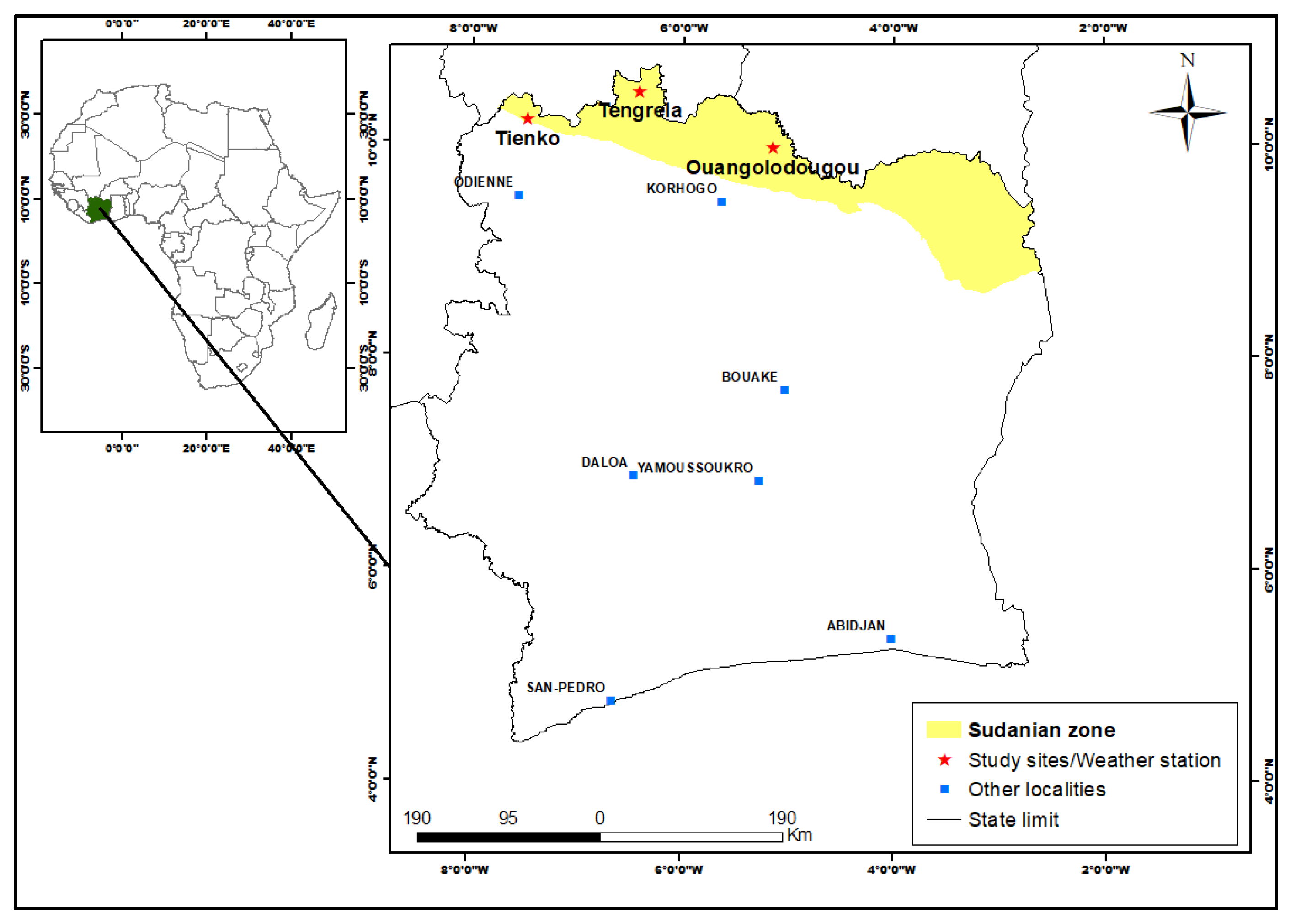
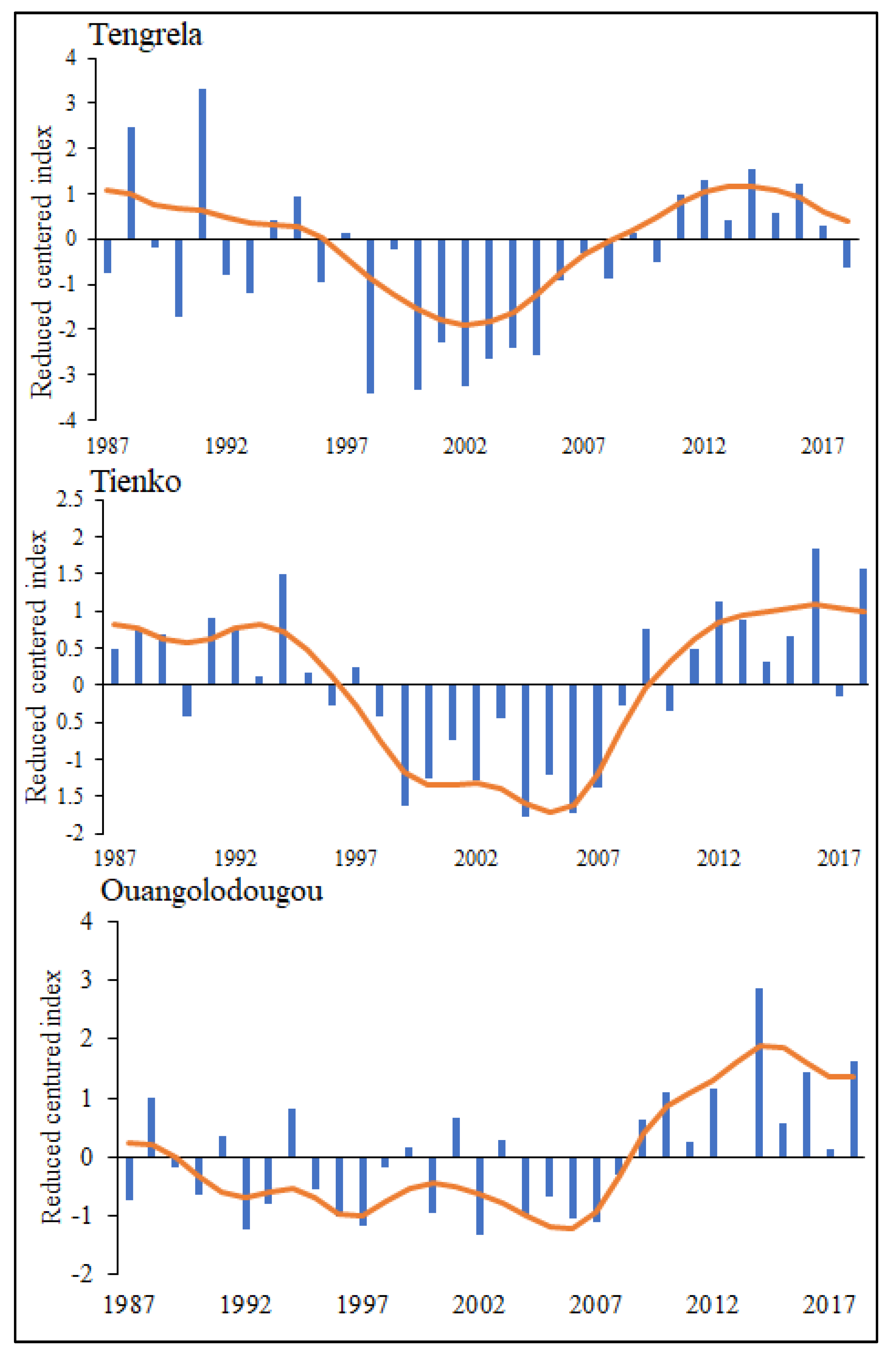
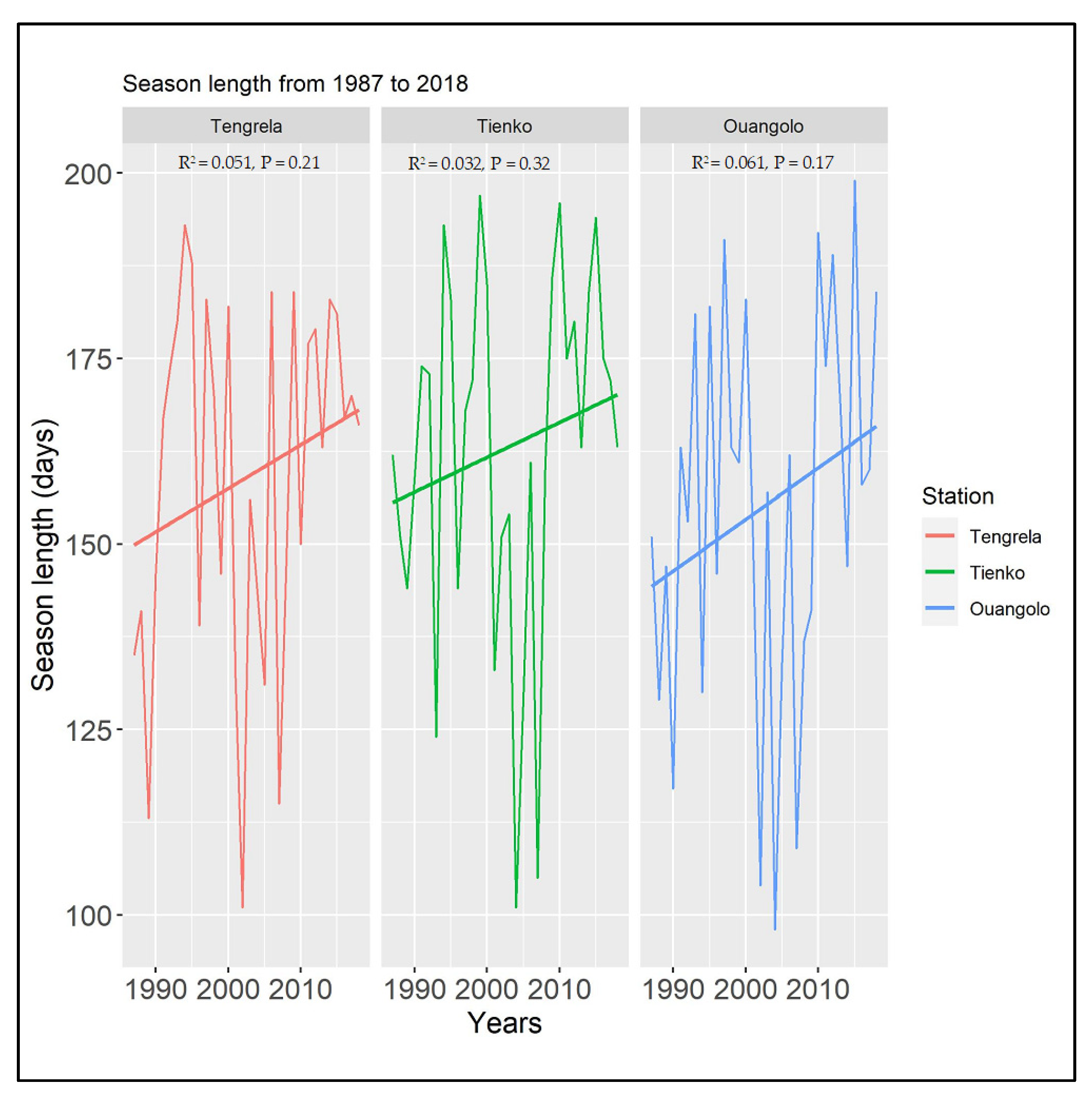
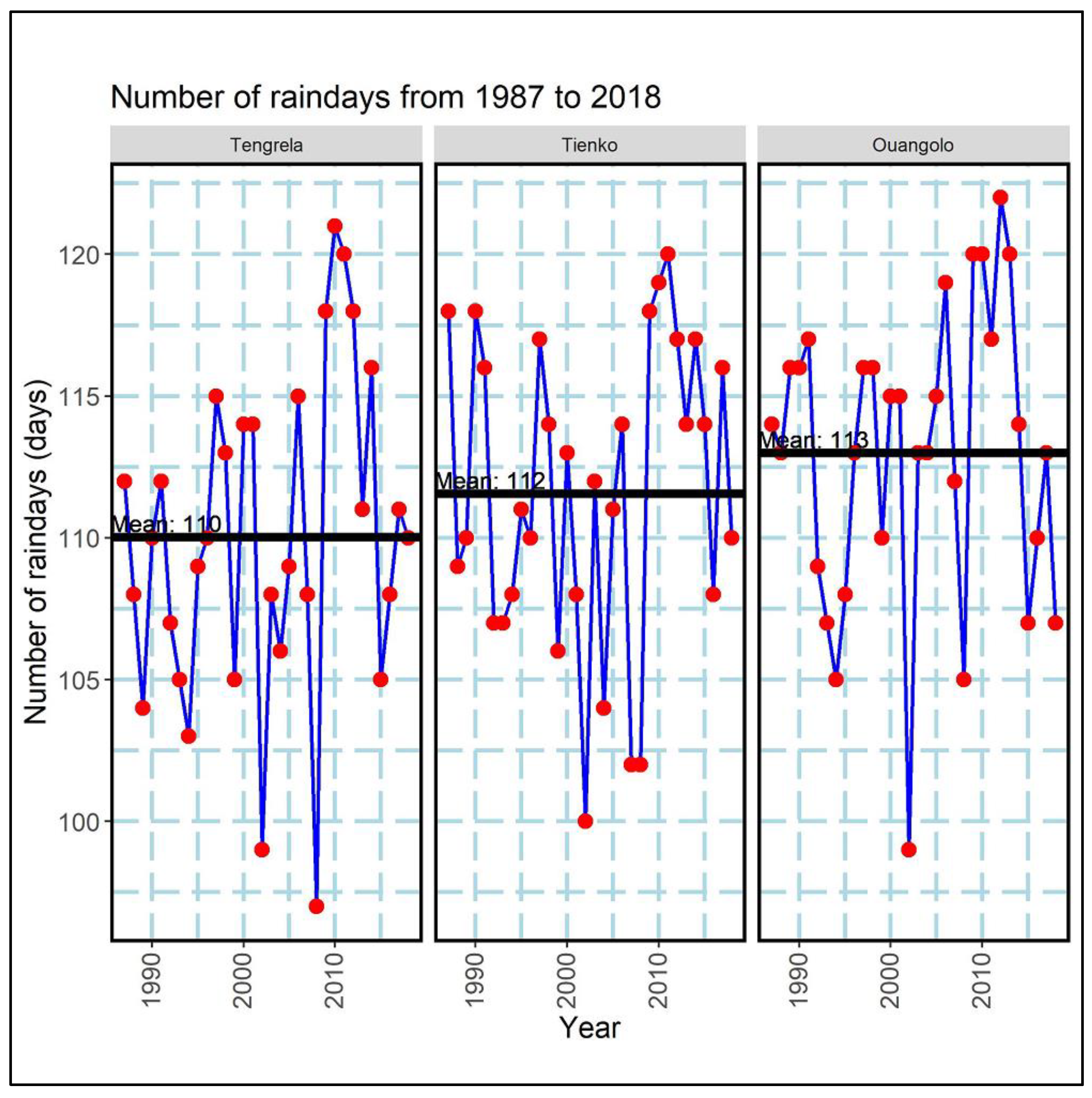
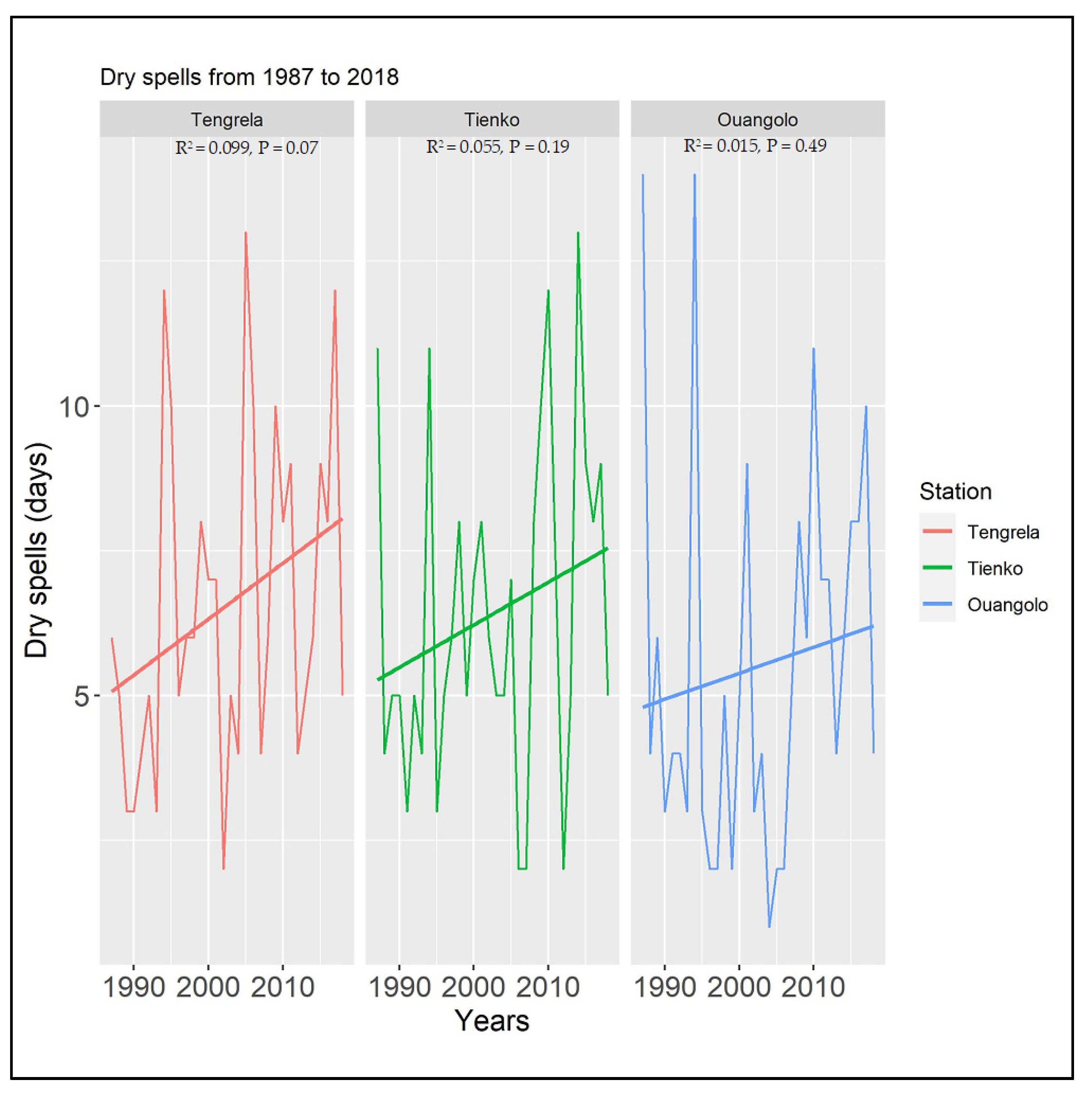
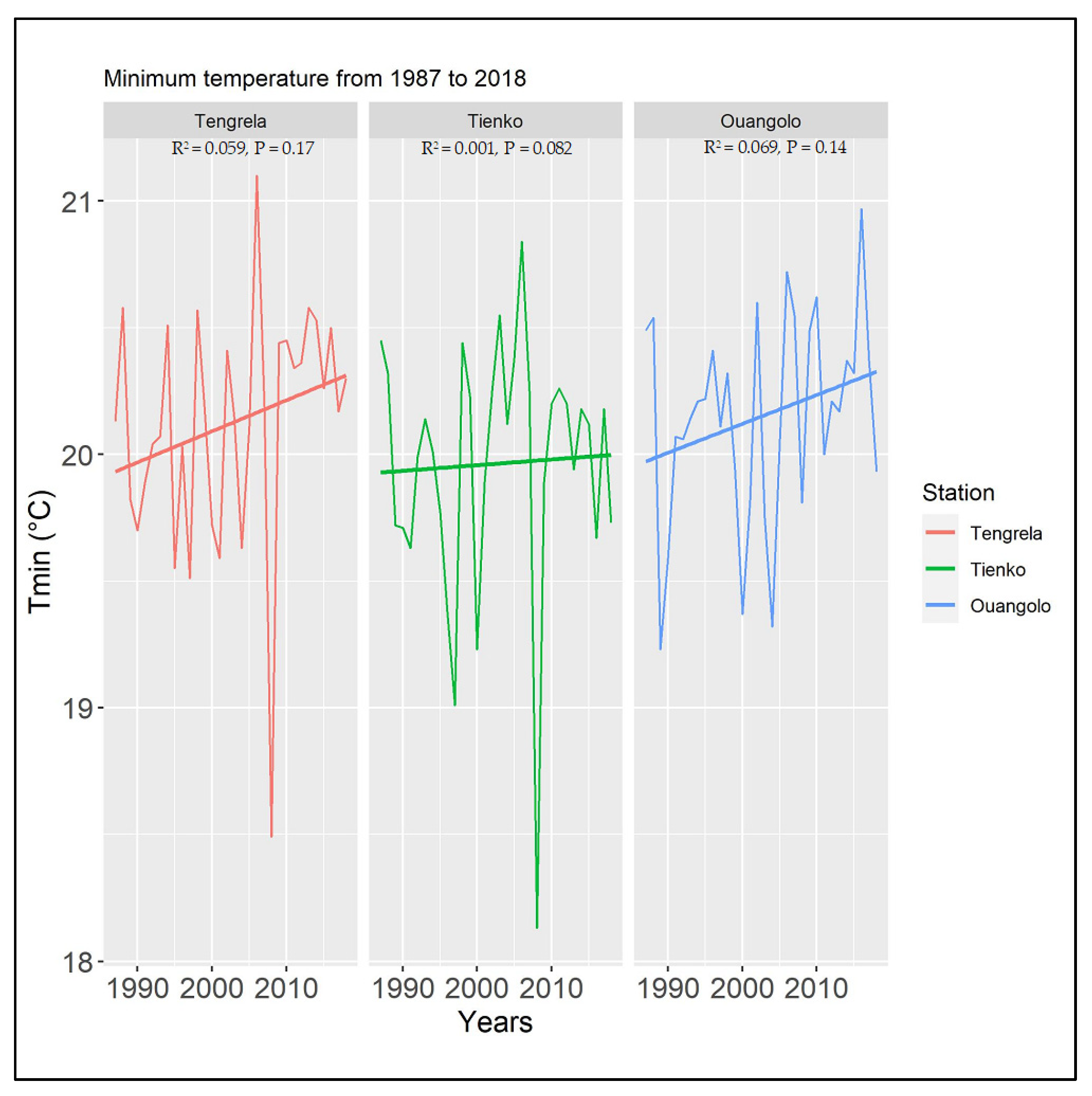

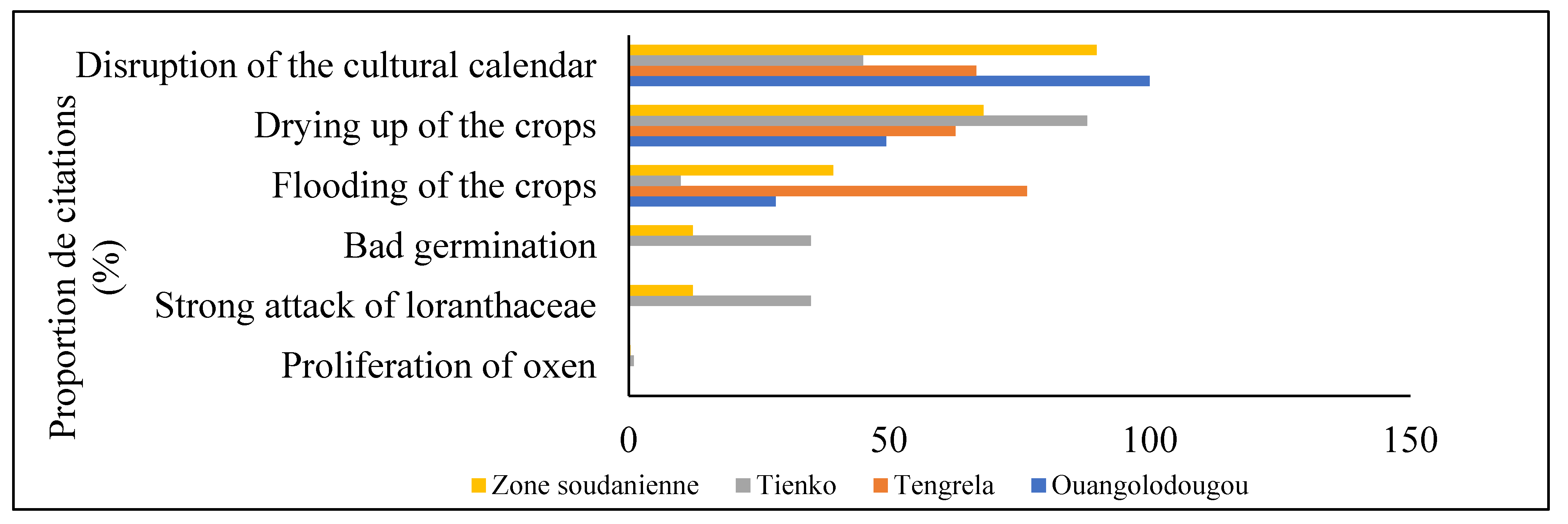
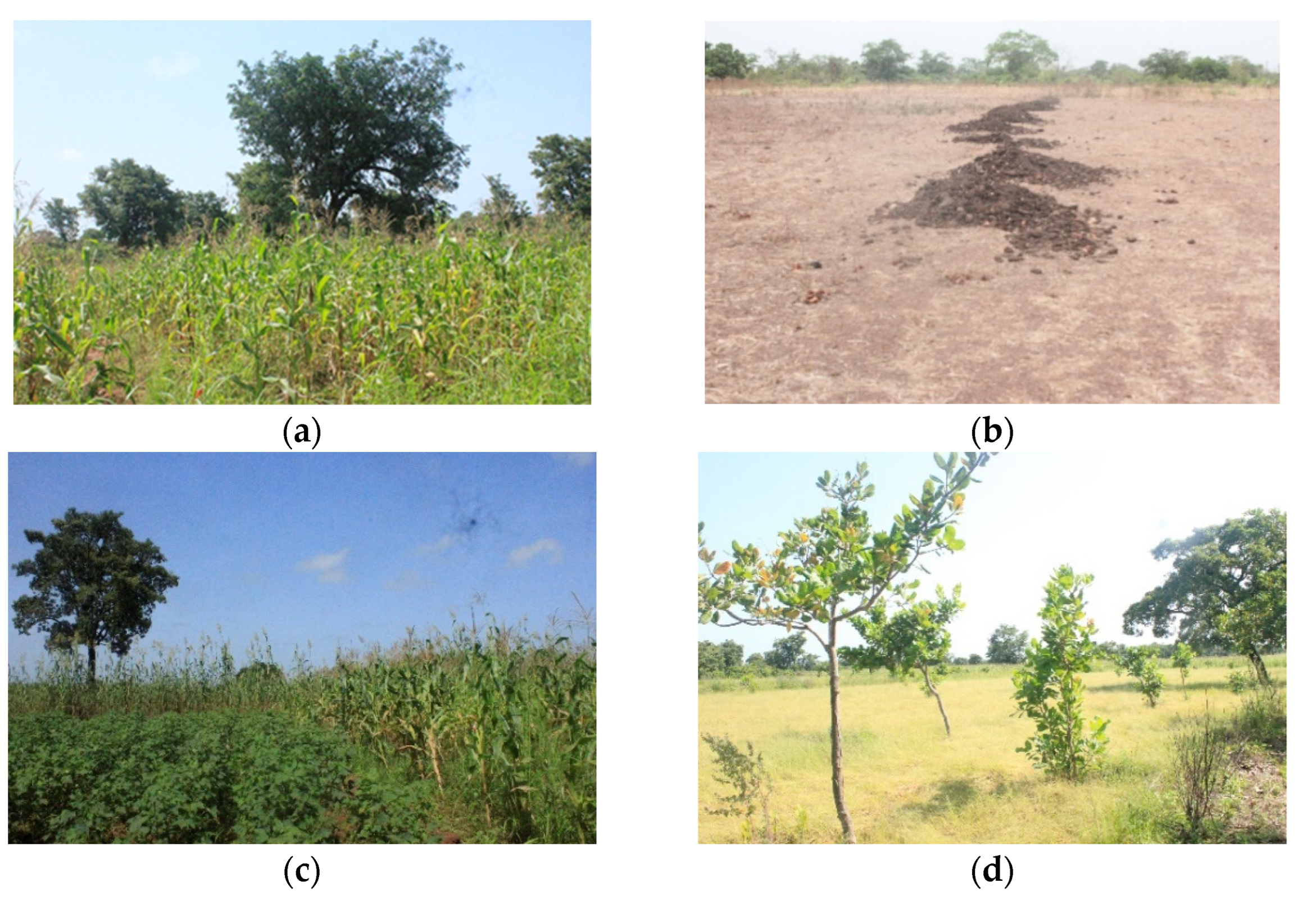
| Profile of Farm Managers | Proportion of Citations (%) | ||||
|---|---|---|---|---|---|
| Sudanian Zone (n = 287) | Ouangolodougou (n = 85) | Tengréla (n = 102) | Tienko (n = 100) | ||
| Average age | 49.33 | 50.64 | 48.38 | 49.04 | |
| Sex | Female Male | 15.11 84.89 | 11.50 88.50 | 8.80 91.20 | 32.00 68.00 |
| Level of education | Without education Educated | 67.97 32.03 | 73,10 26.90 | 76.50 23.50 | 55.00 45.00 |
| Possession of livestock | Yes No | 76.79 23.21 | 87.20 12.80 | 86.30 13.70 | 59.00 41.00 |
| Profile of the Operation | Proportion of Farmers (%) | Pr (>F) | |||
|---|---|---|---|---|---|
| Sudanian Zone (n = 287) | Ouangolodougou (n = 85) | Tengréla (n = 102) | Tienko (n = 100) | ||
| Average number of animals | 8.00 | 5.00 a | 11.00 b | 9.00 ab | *** |
| Average number of people | 17.00 | 16.00 a | 17.00 a | 15.00 a | NS |
| Average farming experience (years) | 27.90 | 30.41 b | 26.62 a | 26.40 a | NS |
| Average area planted (ha) | 15.00 | 14.00 ab | 17.00 b | 11.00 a | *** |
| Main crops | |||||
| Cashew | 93.72 | 93.59 | 93.14 | 100.00 | |
| Cotton | 59.58 | 78.20 | 76.47 | 28.00 | |
| Corn | 89.19 | 87.18 | 96.08 | 88.00 | |
| Rice | 70.73 | 73.08 | 60.78 | 77.00 | |
| Peanut | 40.76 | 61.54 | 22.55 | 41.00 | |
| Sorghum | 17.07 | 11.54 | 38.23 | 0.00 | |
| Perception of climate variability | 99.60 | 100.00 | 99.00 | 100.00 | |
| Signs of Climate Variability Evoked | Proportion of Citations (%) | Pr (>F) | |||
|---|---|---|---|---|---|
| Sudanian Zone (n = 287) | Ouangolodougou (n = 85) | Tengréla (n = 102) | Tienko (n = 100) | ||
| Increase in temperature | 13.60 | 7.06 a | 15.68 a | 17.00 a | NS |
| Increase in precipitation intensity | 12.20 | 37.65 b | 2.94 a | 0.00 a | *** |
| Dense fog | 0.35 | 1.18 a | 0.00 a | 0.00 a | NS |
| Irregularity of precipitation | 84.67 | 58.82 a | 91.18 ab | 100.00 b | *** |
| Prolonged drought | 23.70 | 44.70 c | 28.43 b | 1.00 a | *** |
| Shortening of the rainy season | 75.95 | 67.06 a | 83.33 ab | 85.00 b | *** |
| Drying up of rivers | 9.06 | 8.23 ab | 16.67 b | 2.00 a | *** |
| Line Labels | Proportion of Citations (%) | Pr (>F) | |||
|---|---|---|---|---|---|
| Sudanian Zone (n = 287) | Ouangolodougou (n = 85) | Tengréla (n = 102) | Tienko (n = 100) | ||
| Abandonment of certain drought-sensitive crops | 6.96 | 3.53 a | 5.88 a | 11.00 a | NS |
| Adaptation of the crop calendar | 86.41 | 90.59 a | 88.23 a | 81.00 a | NS |
| Practice of agroforestry | 5.57 | 0.00 a | 11.76 b | 4.00 ab | *** |
| Increase in the size of the ridges | 2.78 | 4.70 a | 3.92 a | 0.00 a | NS |
| Increase in the surface of the crops | 11.14 | 3.53 a | 8.82 a | 20.00 b | *** |
| Change in activity | 0.34 | 0.00 a | 0.00 a | 1.00 a | NS |
| Crop diversification | 16.37 | 27.06 b | 0.98 a | 23.00 b | *** |
| Cashew nut cultivation | 87.14 | 85.89 a | 88.23 a | 87.00 a | NS |
| Use of improved varieties | 49.12 | 91.76 b | 25.49 a | 39.00 a | *** |
| Replanting | 0.34 | 0.00 a | 0.00 a | 1.00 a | NS |
| Crop rotation | 5.57 | 2.35 a | 11.76 b | 2.00 a | *** |
| Animal traction | 9.05 | 0.00 a | 13.72 b | 12.00 b | *** |
| Use of cotton stalk ash | 4.52 | 0.00 a | 10.78 b | 2.00 a | *** |
| Use of organic manure | 22.64 | 11.76 a | 45.10 b | 9.00 a | *** |
| Use of chemical fertilizers | 21.25 | 1.18 a | 45.10 b | 14.00 a | *** |
| Use of pesticides | 12.89 | 11.76 a | 12.74 a | 14.00 a | NS |
Publisher’s Note: MDPI stays neutral with regard to jurisdictional claims in published maps and institutional affiliations. |
© 2022 by the authors. Licensee MDPI, Basel, Switzerland. This article is an open access article distributed under the terms and conditions of the Creative Commons Attribution (CC BY) license (https://creativecommons.org/licenses/by/4.0/).
Share and Cite
Timité, N.; Kouakou, A.T.M.; Bamba, I.; Barima, Y.S.S.; Bogaert, J. Climate Variability in the Sudanian Zone of Côte d’Ivoire: Weather Observations, Perceptions, and Adaptation Strategies of Farmers. Sustainability 2022, 14, 10410. https://doi.org/10.3390/su141610410
Timité N, Kouakou ATM, Bamba I, Barima YSS, Bogaert J. Climate Variability in the Sudanian Zone of Côte d’Ivoire: Weather Observations, Perceptions, and Adaptation Strategies of Farmers. Sustainability. 2022; 14(16):10410. https://doi.org/10.3390/su141610410
Chicago/Turabian StyleTimité, Nakouana, Akoua Tamia Madeleine Kouakou, Issouf Bamba, Yao Sadaiou Sabas Barima, and Jan Bogaert. 2022. "Climate Variability in the Sudanian Zone of Côte d’Ivoire: Weather Observations, Perceptions, and Adaptation Strategies of Farmers" Sustainability 14, no. 16: 10410. https://doi.org/10.3390/su141610410
APA StyleTimité, N., Kouakou, A. T. M., Bamba, I., Barima, Y. S. S., & Bogaert, J. (2022). Climate Variability in the Sudanian Zone of Côte d’Ivoire: Weather Observations, Perceptions, and Adaptation Strategies of Farmers. Sustainability, 14(16), 10410. https://doi.org/10.3390/su141610410





